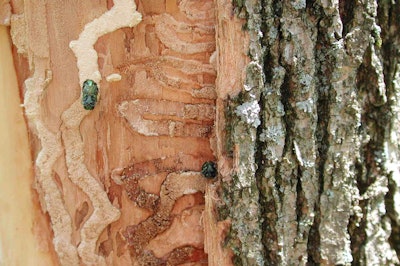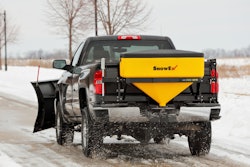 Adult emerald ash borers emerge from an infested ash tree. They did their damage beneath the bark as larvae.
Adult emerald ash borers emerge from an infested ash tree. They did their damage beneath the bark as larvae.No doubt city officials in much of the United States can sympathize with their counterparts in Champaign, Illinois. Many of them are in the same boat, as emerald ash borer infestations continue to decimate North America’s ash trees.
In Champaign, public works staff members told the City Council this week they need to spend $700,000 to continue the removal of dead or dying ash trees from the city right-of-way, according to a report in The News-Gazette. While the city has already removed 659 ash trees, 1,481 remain on city property and are slated for removal. The infestation is expected to kill all of them eventually.
A city worker told the council there are probably two to three times more ash trees on private property, The News-Gazette reported.
Native to Asia, the emerald ash borer – a beetle – was first discovered in North America in 2002, near Detroit. It is believed to have come to the United States in wooden packing material. Since then it has killed hundreds of millions of ash trees and cost municipalities like Champaign – along with nursery operators, forest products industries and private property owners – hundreds of millions of dollars, according to a website maintained by the U.S. Department of Agriculture and several major universities.
While it has not spread to every state, it hasn’t slowed down, either. Among the more recent discoveries were emerald ash borer infestations in Louisiana in the winter of 2015, Texas in the spring of 2016 and Nebraska just this summer.
For landscape companies that handle tree care, especially tree and stump removal, there’s likely to be a steady stream of work for years to come as property owners’ ash trees succumb to the borer over time. That’s because there’s no stopping the emerald ash borer once it invades the tree.
The tree may live for a few years after infestation; indeed, it can take some time to show signs of the damage done by the emerald ash borer larvae, which feed on the tree beneath the bark.
Although the adult beetles feed on leaves, they do relatively little damage. It’s the larvae boring underneath the bark that eventually kill the tree by preventing water and nutrients from circulating through the trunk and branches.
In Champaign, the first confirmation of emerald ash borer infestation within the city limits was just over four years ago.










